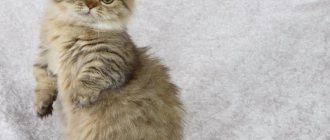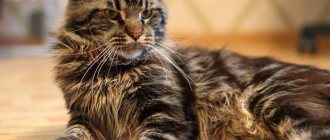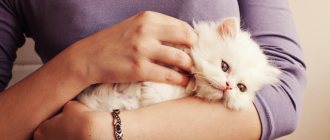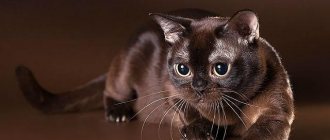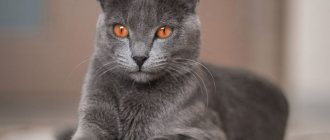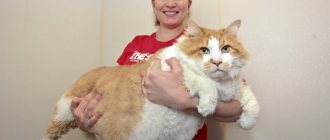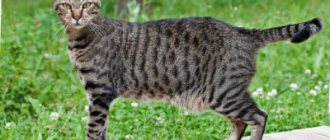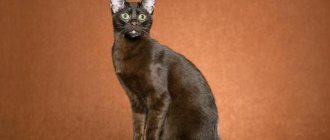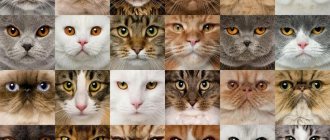https://twizz.ru/wp-content/uploads/2018/09/2-12.jpg
All cat lovers have dreamed of petting a tiger at least once. Or a lion. Or a snow leopard. Well, or any other big cat that you just can’t pet - after all, each of them is a huge paradise on its paws! Fortunately, we have domestic cats, who are just as wonderful. Only small ones.
However, in nature there are compromise options. Today we want to show you the largest breeds of domestic cats from all over the world, which in size are as close as possible to real tigers and lions, only they (most likely) will also agree to live with you without biting off other people’s limbs for fun.
Top 10 biggest cats
Among the representatives of the largest breeds of domestic cats there are long-legged, lean, short-haired beauties and shaggy hulks with a somewhat predatory appearance.
The giants of domesticated representatives of the cat world, whose weight reaches fifteen kilograms or even more, include individuals of only a few breeds, and their prices are sometimes off the charts. Pets weighing from 7 to 12 kg are not so rare, but they look no less impressive and respectable. It is worth saying that cats, invariably included in the ranking of the largest, are mainly distinguished by their physique - solid bones, powerful muscles, and not at all by how well they are fed by their adoring owners. Without exception, all mustachioed giants reach their prime only by 3-4 years, and it is at this age that their individual weight is established. The overwhelming majority of males are much larger than females. Depending on the breed and litter, the difference in weight between them varies and can range from three to five to six kilograms.
Breeds of the world's largest domestic cats
When selecting applicants, the key criterion was their weight. The TOP included everyone who reaches at least 9 kg in the upper range.
Maine Coon (5.4-12 kg)
First place deservedly goes to Maine Coons. It is important to note that the main heavyweights here are males. Thanks to pronounced sexual dimorphism, you can always easily recognize a girl. According to the standard, it should weigh no more than 5.4 kg.
The appearance of the Maine Coon is the result of a long life in Maine. Due to the cold and snowy continental winter, the cat acquired not only a thick undercoat, but also additional tufts of hair on its paws. Their main task is to ensure free sliding on an icy surface.
Maine Coons are monogamous. Only one owner receives all their love, but the rest also receive portions of warmth and affection. Friendly and calm, Maine Coons never become tyrants and are happy to take part in games with other pets.
“
More about the Maine Coon breed
Ragamuffin (7.5-10 kg)
This fluffy big guy is a close relative of the ragdoll. He was born as a result of a large-scale conflict between breeders. The breakaway part decided to go its own way and crossed Ragdolls with “Persians”, “Himalayans” and ordinary cats.
INTERESTING!
By the age of 2 years, a noticeable fold of fat appears on the Ragamuffin’s belly, but there is no need to put your pet on a diet because of it. This breed characteristic has nothing to do with obesity.
Unlike Ragdolls, Ragamuffins are less phlegmatic. They are more often on the move and love to play in friendly company. Their innate friendliness is enjoyed by kids who dress up their pets in doll dresses and other extravagant outfits.
Siberian (7-10 kg)
The powerful body and muscular paws of these cats harmoniously combine with their sweet and graceful faces. Thick fur gives extra volume to the body. Its length varies depending on the time of year. In hot summers, only the tail retains fluffiness, so the “Siberian” can be confused with an ordinary yard cat.
It is better to keep these hardy and unpretentious “mustaches” outside the city, where there is room for free walking and honing hunting skills. Living in an apartment is also acceptable, but subject to regular walks with a harness.
“ More about the Siberian cat breed
Neva Masquerade (6-10 kg)
Neva Masquerade Dogs have a proportional build and a voluminous chest. Their luxurious semi-long wool is a gift inherited from the “Siberians”.
Together with her, they also inherited seasonal molting. The thick mane around the neck and smart “pants” almost completely disappear with the arrival of warmth.
Unlike the “Siberians”, the Neva Masquerade Dogs behave more calmly and balancedly. Thanks to this, they easily adapt to any conditions. In apartments they lead a mostly “sofa” lifestyle, and outside the city they mercilessly eliminate pests of garden beds and bushes: moles, mice and birds.
“ More about the Neva Masquerade breed
Ragdoll (6-10 kg)
The long, muscular and massive body of the Ragdoll has low muscle tone. Because of this, they, like rag dolls, go limp when picked up. For the same reason, from the age of 8, their abdomen begins to sag, regardless of proper nutrition.
Ragdolls are very gentle and vulnerable creatures with a fine mental organization. They become very attached to their owners and have a hard time with separation. When choosing between waiting for a person to return from a business trip and traveling together to another country, Ragdolls will happily choose the latter.
“ More about the Ragdoll breed
Norwegian forest (5.5-10 kg)
The already large dimensions of the Norwegian Forest are increased by its fluffiness. The thick fur has water-repellent properties and remains dry in bad weather. The longest hairs form the “collar” and “pants”.
INTERESTING!
Thanks to their tenacious claws and muscular paws, Norwegian forest animals climb down from trees like squirrels, head down. All other “mustaches” do it the other way around and turn over only before jumping to the ground.
Despite the ostentatious severity, Norwegian forest dogs are very playful and good-natured. In the absence of health problems, they chase balls and mice with great enthusiasm even in old age. They are also not characterized by aggression, so Norwegian Foresters get along well with other pets and never offend even the most annoying children.
“ More about the Norwegian Forest Cat breed
Turkish van (6-9 kg)
The impressive appearance of the Turkish Van is the merit of a well-developed muscle corset. Unlike other “fluffies”, they cannot boast of a luxurious “jabot” or “collar”. The longest fur covers only their thighs and tail, which resembles a fan.
Turkish Vans do not idolize their owners and choose only one “favorite” among them. They perceive the latter as an equal, avoiding obsessive following. It is very easy to determine who is lucky. The cat will always respond to his call and any, even careless, stroking of the head.
American Bobtail (5-9 kg)
The bobtail's short ponytail is the result of a genetic mutation, the inheritance of which was fixed by breeders. Its length varies between 2.5-10 cm.
Sensitive and flexible bobtails quickly gained popularity in the United States. Thanks to their ability to accurately capture human emotions, they were attracted to feline therapy.
High intelligence and easy-going nature make it easy to teach bobtails simple tricks: fetching toys on the “Fetch” command and opening doors. Also, “short-tailed” dogs quickly get used to walking on a harness.
Savannah
Savannah, the largest domestic cat on the planet, is one of the rarest, most expensive, exotic and young breeds. Selection work on its breeding began in the 80s of the last century and took place in stages. In fact, the Savannah is a hybrid of a domestic cat and an African serval - a predatory mammal, a close relative of the lynx and caracal, but in its color this beauty is more reminiscent of a cheetah. Her homeland is the USA, or rather, one of the farms in the state of Pennsylvania, where, as a result of crossing a serval and a domestic Siamese cat, a female was born, who was named Savannah - it was she who became the ancestor of the new breed. Later, breeders included Bengal cats, Egyptian Mau, and Ocicats in the selection process. The breed standard was officially approved in 2001.
Savannah is a magnificent strong animal whose weight reaches 15 kg, and sometimes exceeds this figure. The length of the cat's body is about a meter, and the height at the withers is about half a meter. Distinctive features of her appearance are an elongated neck, a nobly set head, tall slender limbs, thick fur, and large ears.
Despite the fact that the Savannah has a wild and, one might even say, unkind look, it is not at all aggressive. This cat is quite sociable, friendly to children, devoted to its owner, understands commands perfectly, like a dog, and is ready to walk on a leash without whims. However, in urban conditions, the savannah experiences discomfort, as it needs an active lifestyle. She must be able to realize her instincts: climb to heights, hunt, jump, demonstrating the wonders of tightrope walking - from a standing position, this pet can easily “jump” 3.5 meters vertically. Savannahs are not at all afraid of water; on the contrary, they are not averse to swimming a fairly decent distance.
Not all savannahs are the same: their size and habits depend on the degree of kinship with their wild ancestor - the serval. The cats that are the least distant from the serval are those designated as an F1 hybrid. These are the heirs of the first generation of mating animals - wild and domestic. They are the largest, rarest and, accordingly, expensive. The higher the number after F, the less Serval blood the Savannah has. F7 hybrid animals, for example, are similar in build and size to a regular domestic cat. Savannah kittens can cost anywhere from $4,000 to $20,000.
In 2006, representatives announced the appearance of a new breed of cat - the Asher. These animals were the result of crossing a Bengal cat, an Asian leopard cat and a serval cat. Initially, the cost of a kitten in the nursery was 20 thousand dollars, but despite this, Ashera quickly gained popularity. It soon became clear, however, that the DNA of these felines is identical to that of the Savannah, so this breed is not recognized today as a separate breed. However, these exotic-looking cats remain in high demand, and their prices have dropped significantly.
Savannah (Asherah)
The largest breeds of domestic cats mixed with wild ones
Due to their close relationship with wild cats, all representatives from this group have quite impressive dimensions. When maintaining them, it is very important to take into account one point - the danger of the first generations. Due to their developed predatory instincts, they often show aggression and can injure their owners.
Savannah (10-15 kg)
The African serval hybrid is notable not only for its weight, but also for its length. Its maximum value reaches 1 m. The heaviest and largest are savannahs of the F1 generation. With the decrease in the amount of wild blood, the animals become more and more like an ordinary “murka”.
The innate tendency to dominate in savannahs is successfully eliminated by castration. After the operation, they become calmer and more tolerant, but they can still periodically show their leadership habits.
Savannahs are especially indignant at strangers, perceived as potential invaders of the territory. If guests come to your house, don’t be surprised that your pet greets them with grumbling and a terrifying hiss.
“ More about the Savannah (Asher) breed
Caraquet (10-15 kg)
Due to its close relationship with the caracal, the caracal reaches 1.5 m at the withers and 1 m in length. The animal's ears must have tassels - the calling card of the steppe lynx. Caraquet wool has a hypoallergenic property, which explains the popularity of the breed among allergy sufferers.
Docile and friendly, caraquets love to travel and become very attached to their owners. They show wary curiosity towards strangers, and in case of danger, they yelp like dogs.
Serengeti (10-15 kg)
These cats were obtained by crossing "Bengals" and "Orientals" with a spotted color. As a result, the Serengeti received large sizes and exotic colors, but retained the ability to reproduce in the first generations. This distinguishes them from Savannah males, which are sterile until the F4 generation.
INTERESTING!
In their courage and devotion to man, the Serengeti resembles dogs. To protect their owner, they are ready to fight with a dangerous enemy.
Due to the minimal blood content of a wild animal, the Serengeti is very good-natured and sociable. Aggression on their part is possible only for two reasons: defense of territory and irritation against the background of prolonged loneliness. Due to their innate dominance, the Serengeti does not get along well with other pets, but they enjoy playing with their owners’ children.
Chausie (10-15 kg)
Chausie is the result of natural hybridization with jungle cats. Despite subsequent matings with the “Abyssinians,” they still retained their impressive dimensions.
Chausies are clean and balanced intellectuals. They easily learn to use the litter box, do not engage in exhibition fights with other pets, and spend time with their owners with great pleasure.
Due to their high intelligence, the Chausie can be taught basic commands. The easiest one to perform is fetching, as these cats love to chase balls and toy mice.
“ More about the Chausie breed
Toyger (7-10 kg)
Those with a luxurious brindle color are another close relative of the Bengal. Unlike the Serengeti, ordinary outbred cats were used to produce them.
The final size of the Toygers turned out to be larger than that of the Bengals. According to the developed standard, an overly refined silhouette was equated with a disadvantage, and a muscular and strong body with a weighted front part of the body was taken as a model.
Toygers love to be the center of attention and are not selective in their communication. They quickly find a common language with other four-legged animals, strangers and small children.
Bengal (4-9 kg)
It was obtained by crossing a purebred black cat and a wild leopard cat. The unique bright color is the result of the influence of the genes of the second parent. Animals from the first three generations reach their maximum weight. Starting from F4, their body weight ranges from 4.5 to 7 kg depending on gender.
IMPORTANT!
Bengals are prone to viral leukemia. It cannot be treated, so to prevent it it is very important to take care of vaccination against the pathogen.
Bengals retain their energy and playfulness into old age. Lack of activity has a destructive effect on them. If your cat has nothing to do with himself, then furniture, wallpaper and curtains will be the first to suffer.
“ More about the Bengal cat breed
Maine Coon
Second place in the list of the largest cats is occupied by Maine Coons. Giant cats of the Maine Coon breed became known in the middle of the 19th century, when they began to be shown at fairs held in the northeastern American state of Maine. Legends that Maine Coons appeared as a result of crossing domestic cats and wild animals, including raccoons and lynxes, are still popular. The Maine Coon supposedly inherited its distinctively colored tail from the raccoon, and its charming ear tufts from the lynx. These spectacular versions are beautiful, but from a genetic point of view they do not stand up to scrutiny. Dog handlers are confident that the breed formed independently, as a result of natural evolution, but is intraspecific.
Maine Coons reach maturity in their fourth year of life. At this age, their weight can be 12-15 kg. They have a large and long body, a powerful chest, well-developed muscles, thick, strong paws. In addition to their power, Maine Coons can also be proud of their luxurious thick coat. Another distinctive feature of the appearance of this animal is its incredibly fluffy tail, which the cat uses to wrap itself in the cold season.
Maine Coons have a wonderful character - soft and accommodating. They are intelligent, smart, friendly, but do not tolerate familiarity. These cats love to live in pairs. Male Maine Coons are excellent fathers, enthusiastically taking part in raising their offspring along with females.
The longest cat belongs to the Maine Coon breed. A male named Stu, a native of Nevada, is known for measuring 1.23 m from the tip of his nose to the tip of his tail.
Maine Coon
Chausie
Large, stately and elegant Chausies are young cat breeds. They were developed in the USA in the 60s of the last century, and were registered only at the beginning of this century. The Chausie was created by crossing the Abyssinian domestic cat and the wild jungle cat, also known as the marsh lynx.
Chausies are athletically built, they have a long body, and the height at the withers can reach 40 cm, which puts them in third place in our ranking of the largest cats. The weight of an adult male reaches 14.5 kg. These amazing cats have a completely wild appearance. Their coloring, predatory look, and hunting habits make you wonder if you should be afraid of them. But upon closer acquaintance, it turns out that the chausie is the sweetest creature: affectionate, gentle, peaceful, loving to purr, and quite loudly.
From their predatory ancestors, these cats inherited a passion for hunting, a love of water and a desire to conquer heights. They love to stock up, often sneaking unattended food from the kitchen. They should be fed raw meat and fish, quail eggs; cereals are contraindicated for them.
Chausie is a very rare breed of cat because it is quite difficult to breed them. Chausies are most popular in their homeland - in the USA; there are several nurseries in Europe. In the post-Soviet space, chausie are considered a rarity. The cost of a kitten of this breed can reach $10,000.
Siberian and Neva masquerade cats
The Siberian cat is the pride of Russian breeders and the first domestic breed recognized by all international felinological organizations. The name of the breed, which began to be bred in the late 80s of the last century, is symbolic, since animals common throughout Russia, and not just Siberia, took part in the selection. The largest, strongest animals with heavy bones and thick, long hair were selected for breeding. The result turned out to be excellent: the Siberian cat looks like a real taiga inhabitant: hardy, powerful, big, harsh. The average weight of adult males is 10 kg, but 12-kg Siberians are not at all uncommon.
Siberian cats have a strong nervous system and high intelligence. They are calm, reasonable, patient with children, and attached to their owner like dogs. These cats are fearless and excellent hunters.
The Siberian cat rightfully takes fourth place in our ranking of big cats, and to it we will also add the Neva Masquerade cat, which is considered its subspecies. Breeders from the Kotofey club bred this magnificent breed under the guidance of felinologist Olga Mironova and presented it at her cat show in 1988. The Neva Masquerade cat owes its name to the Neva River, on which St. Petersburg stands, and the color of its face, similar to a carnival mask.
Today, breeding of Siberian cats is carried out in the USA, Canada, Great Britain, Germany, Spain, Italy, Finland and other countries. The number of nurseries located around the world is more than three hundred.
Siberian cat
Neva masquerade cat
Ragdoll and ragamuffin
The top five largest cats in the world are ragdolls, along with their charming subspecies - ragamuffins. Ragamuffin, which means “ragamuffin” in English, is the creation of the creative American breeder Anne Baker, also known as the founder of the Ragdoll breed. Actually, Ragamuffins are ragdolls crossed with mongrel cats. Their appearance is very reminiscent of ragdolls, but these delightful creatures have a richer palette of colors. Ragamuffins can be long-haired or short-haired.
Representatives of this breed have an elongated, strong, muscular body; by the age of four years, the age of full maturity, they can gain weight up to 10 kg. Ragamuffins are similar in character to ragdolls: they are just as gentle, affectionate, in need of the love and attention of their owner, and, despite their impressive size, completely defenseless against the aggression of other animals.
The breed was introduced in 1994, but numerous ill-wishers of Ann Baker for a long time prevented the official recognition of Ragamuffins. Only in 2003 these cats received a status separate from ragdolls and were recognized by international canine organizations.
Ragdoll
Norwegian Forest Cat
Luxurious Norwegian forest cats are the pride of all of Scandinavia, where they are considered aboriginal animals. Presumably their ancient ancestors are long-haired representatives of the cat tribe brought to these harsh northern regions. As a result of natural selection and adaptation to the Scandinavian climate, they became the founders of a special population of cats - large, strong, distinguished by endurance and very thick hair. At the beginning of the last century, the Norwegian authorities provided official protection to native wild cats, obliging foresters and rangers in nature reserves to fight back against poachers who caught these beauties en masse and took them out of the country. In the 1930s, breeders began systematically breeding Norwegian forest cats to avoid extinction of the animals, while preserving their pristine beauty. The Norwegian Forest Cat breed was officially recognized only in 1977.
The Norwegian Forest Cat looks powerful yet elegant. It has a strong, elongated body, the hind limbs are noticeably longer than the front, which is more typical for a lynx than for a domestic cat. This proportion allows this animal to descend from a height head down in a spiral, like a squirrel, which is not typical for most pets. The weight of an adult male can reach 10 kg, but visually, thanks to his luxurious fur, he “pulls” a whole pound.
The Norwegian's character is as magnificent as his appearance. He is an excellent and loyal companion, very inquisitive, sociable, but not annoying. The cat is extremely friendly and is always ready to make friends with other pets.
In the second half of the last century, King Olav V of Norway gave the Norwegian Forest Cat the status of a national breed. In Western and Northern Europe, this charming animal has plenty of fans; in the USA they are not very popular, and in Russia there are only a few nurseries where you can buy a guaranteed purebred Norwegian Forest cat kitten. They operate in Moscow and St. Petersburg.
Norwegian Forest Cat
Chartreuse, 3-7.5 kg
The delicate intellectual from France, Chartreuse , makes an excellent companion. Representatives of this breed are famous for their flexibility, ability to find a common language with any people and goodwill.
Chartreux are not capricious if they are left alone - they feel great both with their family and alone. They do not create disturbances; they are phlegmatic by nature.
Cats of this breed have one peculiarity - they meow very delicately; in addition, they will never bother their owner with loud sounds. Most of the time they prefer to remain silent.
The Chartreuse is an amazing cat in many ways, she has a gentle character and an attractive appearance. The animal is very reasonable and decent.
British shorthair cat
The British Shorthair cat is one of the oldest and largest English breeds. The ancient ancestors of these animals are presumably cats, brought to Britain by Roman legionnaires before our era. Over the centuries, they have interbred not only with each other, but also with native wild cats. British Shorthair cats became known as a breed in 1871, when they were presented at the London Cat Show, after which they gained extreme popularity. However, at the beginning of the twentieth century, the fashion for these cats passed, and by the 50s their population had decreased significantly. To preserve the breed, breeders began crossing the few representatives of the British Shorthair with Persian cats, as a result of which today these cats look a little different than a century and a half ago.
The Briton is a large, but quite compact in his constitution strong man, who, thanks to his superbly sculpted muscles and unusual plush fur, looks even more powerful than he actually is. On average, adult cats weigh up to 9 kg, but some pets weigh up to 12 kg. This is usually due to the fact that representatives of this breed are prone to obesity because they become inactive as they age. By their nature, British Shorthair cats are calm and independent, they treat others selectively, and do not allow strangers to approach them at all.
There is an opinion that the illustrations for the book “Alice in Wonderland”, created by the English artist John Tenniel, depict a British shorthair cat. Today the Briton is the recognizable “face” of the Whiskas brand.
British shorthair cat
Pixie bob, 5-10 kg
This cat is happily adopted by those who prefer to keep a small lynx at home, because the pixie-bob looks so much like her!
This breed was bred artificially, resulting in a cat with an exotic appearance and a kind character. These animals are popular in the USA, they are often found in local legends, and even the famous traveler and cat lover Hemingway mentioned them in his works.
Pixie Bobs are compared to dogs because this breed is extremely attached to their owner. For this reason, they are not advised to be left alone for a long time - they will become sad and despair. A cat of this breed can be affectionate, loves to play and gets along well with children.
Pixiebob
The breed, known today as the pixie bob, was originally formed through the process of cross-breeding in natural conditions between a domestic cat and a bobcat, a wild lynx. Due to the fact that these animals have the same karyotype, their offspring turned out to be fertile. In the 80s of the last century, American felinologists, having caught three wild individuals in the forest, began breeding them, trying to preserve the original appearance of the animal. In 1998, the new breed received the right to participate in the championships of the world's largest felinological organization TICA.
Externally, the pixie bob resembles a small lynx with a short tail. He has a powerful body, strong paws, and a wild, slightly gloomy look. The weight of an adult pet is 7-9 kg. Despite its stern and menacing appearance, the pixie-bob is a fairly peaceful, calm creature. It is not aggressive, rarely releases its claws, and will not bite a person at full strength. These cats are similar to dogs in their behavior and devotion. Pixiebobs do not meow, but when they play with each other, they growl. Their purring is not like the songs of domestic cats - it is very loud and heavy. These animals do not welcome other pets, but they also do not enter into conflicts with their four-legged brethren - they simply maintain their distance.
Pixie bobs produce few offspring - there are usually 2-3 kittens in a litter. This rare breed is recognized as a national treasure of the United States. Official permission is required to take cats out of the country.
Pixiebob
Ragdoll, 5-9 kg
The Ragdoll is a unique breed. Kittens are born white and are very friendly with their owners. One can say even more - the owner for this breed is the center of the Universe. You always want to pet a beauty with luxurious fur; she responds to affection with a kind disposition and tenderness.
Those who often have scandals in their family should give up the idea of getting a Ragdoll, because the animal takes everything to heart, and it may even become depressed. The same applies to people who are absent all the time - the cat begins to feel sad and depressed if it is alone for a long time.
These wonderful cats with bright eyes do not require much, the most important thing is that the owner is nearby and there are no scandals in the house.
Turkish van
The ancestors of the Turkish Van are aboriginal semi-long-haired cats, who from time immemorial lived in the area adjacent to Lake Van, located in Turkey. This breed was discovered in the modern world by British journalist Laura Lushington, a big cat lover. From her trips to this region of Turkey in the 50s of the last century, she several times brought charming kittens, with which the breeding of the Turkish Van cat breed in Europe began. Today, the Turkish Van is recognized by all leading felinological international organizations.
An adult Turkish Van cat can weigh up to 9 kg. His body is muscular, long, with a wide, powerful chest. These pets love water fun and swim well. They are very active, sociable, overly inquisitive and emotional. They have a well-developed hunting instinct. In childhood and adolescence, these cats can even show some aggressiveness, biting and scratching their owners. However, with age their character becomes softer.
In Turkey, aboriginal Van cats (they are called van kedisi here) are very revered, are one of the symbols of the country and are listed in the Red Book. They are credited with the gift of bringing happiness and good luck; these animals are even allowed to enter the mosque. It is possible to export Turkish Vans from the country only with official permission.
Turkish van
Chartreuse
The Chartreuse, or Carthusian, as well as medieval cat, is considered a French breed. However, historians in the field of felinology are confident that the ancestors of the Chartreux are cats brought to France from the East during the Crusades. In the 16th century, they were described as stocky animals with an ash-gray color with a blue tint. Initially, these big cats lived at the main monastery of the Carthusian order of Grand Chartreuse, but over time they bred in other regions of the country. After the First World War, French breeders began systematic breeding of the breed, and in 1928, Chartreuse was already taking part in exhibitions. Today, nurseries for breeding Chartreuse are located mainly in France and the USA.
In their appearance, Chartreuse cats resemble British shorthair cats, but they have a different constitution and lack the pronounced plushness of the coat characteristic of the British. When looking at their dense, well-built, compact body and short limbs, it may seem that these pets are lightweight, however, when you pick up a Chartreuse in your arms, you will immediately understand how deceptive this impression is. Adult Chartreux have significant muscle mass and can weigh up to 7 kg. They are very balanced and measured, one might even say phlegmatic. They seem to enjoy observing rather than acting. Chartreux meows very rarely, and their voice is so quiet that it is like a whisper.
It is difficult to find purebred Chartreuse in Russia. Often, even in nurseries under the name “chartreuse” they sell shorthaired blue cats of the British breed, European shorthaired blue cats or hybrids of these breeds. You can purchase a guaranteed purebred kitten in clubs that are members of the international felinological organization FIFe.
Chartreuse
a lion
There are no two absolutely identical lions on the planet. The “facial” features of each animal are unique and belong to only one individual. The body length of the royal individuals of the fauna world is 1.7–2.5 m, height – up to 1.2 m, weight – 160–280 kg. The largest specimen lived in South Africa and weighed 313 kg.
In hunting, the lion is helped by 7-centimeter claws and vision, the acuity of which is 6 times greater than that of a human. Running is not a predator's strong point. At short distances, the giant cat accelerates to 60 km/h, but after 200 m it gets tired and stops pursuing its prey. Lack of stamina forces the animal to get as close as possible to the victim and in a swift jump deliver a fatal blow. Lionesses are lighter and faster than males, and therefore more successful in hunting.

